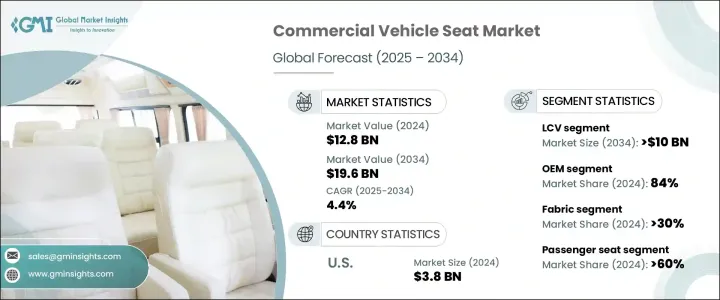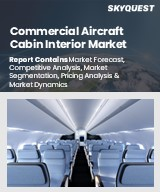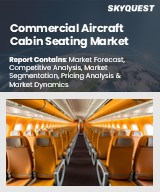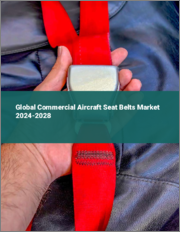
|
시장보고서
상품코드
1698337
상용차 시트 시장 기회, 성장 촉진요인, 산업 동향 분석, 예측(2025-2034년)Commercial Vehicle Seat Market Opportunity, Growth Drivers, Industry Trend Analysis, and Forecast 2025 - 2034 |
||||||
세계의 상용차 시트의 시장은 2024년 128억 달러에 이르렀고, 2025년부터 2034년까지 연평균 복합 성장률(CAGR) 4.4%를 나타낼 것으로 예측됩니다.
상용차, 특히 물류 및 운송 부문 수요 증가는 내구성이 뛰어나고 인체공학적 시트 솔루션의 필요성을 계속 추진하고 있습니다.

시장은 소재, 디자인, 안전 규제의 진보에 추진되어 변혁기를 맞이하고 있습니다.경량으로 에너지 효율이 뛰어난 시트 솔루션은 특히 업계가 전기자동차나 자율 주행차에 축족을 옮기면서 지지를 모으고 있습니다. 모듈식 좌석 구조의 채용도 증가하고 있어 용도의 요구에 따라 유연성을 높여, 커스터마이즈 할 수 있게 되어 있습니다. 또한 엄격한 안전 표준으로 인해 지속적인 혁신이 필요하기 때문에 자동차 제조업체는 글로벌 규제 프레임워크를 준수하는 충격에 강한 인체공학적 시트를 개발해야 합니다.
| 시장 범위 | |
|---|---|
| 시작 연도 | 2024년 |
| 예측 연도 | 2025-2034년 |
| 시작 금액 | 128억 달러 |
| 예측 금액 | 196억 달러 |
| CAGR | 4.4% |
소형 상용차(LCV) 부문은 상용차 시트 시장에서 압도적인 강도를 유지하고 있으며, 2024년에는 55%의 점유율을 차지했습니다. 컴팩트하고 연비가 좋은 차량에 대한 수요가 급증함에 따라 2034년까지 100억 달러를 창출할 것으로 예측되고 있습니다. LCV는 조종성, 연비 효율, 비용 효율성의 매력적인 조합을 제공하기 위해 배송 함대, 승차 공유 서비스 및 대여 사업에 선호되는 선택입니다. 전자상거래의 성장은 첨단 시트 솔루션의 필요성을 더욱 높여주고 있으며, 제조업체는 소비자의 기대치를 높일 수 있도록 램버 서포트 강화, 시트 조정 기능 향상, 지속 가능한 소재에 주력하고 있습니다.
상용차 시트 시장은 OEM과 애프터마켓 판매 채널로 구분되며, 2024년 시장 점유율은 OEM이 84%를 차지했습니다. 자동차 제조업체는 브랜드 아이덴티티, 품질 기준, 진화하는 안전 규제에 따른 공장 장착 시트를 압도적으로 지지하고 있습니다. OEM은 인체 공학적 디자인, 고 내구성 패브릭, 에어컨 시트, 메모리 기능, 조정 가능한 램버 지원 등 고급 기능을 특징으로하는 프리미엄 시트 솔루션에 많은 투자를하고 있습니다. 이러한 기술 혁신은 운전의 쾌적성을 높일 뿐만 아니라 자동차의 효율과 수명도 향상시킵니다. 자동차 제조업체가 뛰어난 인테리어 기능을 제공할 필요가 있을 때, 시트 제조업체는 엄격한 안전 기준에의 적합을 확보하면서, 드라이버와 동승자의 양쪽의 요구에 부응하는 최첨단의 솔루션을 개발하고 있습니다.
북미의 상용차 시트 시장은 세계 매출의 36%를 차지하고 미국은 2024년에 38억 달러의 매출을 기록했습니다. 이 주도적 지위는 이 나라의 광범위한 생산 능력, 견조한 차량 판매, 연구 개발에 대한 지속적인 투자로 인한 것입니다. 자동차 제조업체와 공급업체는 소비자의 선호도 변화에 대응하기 위해 난방, 환기, 메모리 설정 등의 시트 기능을 지속적으로 강화하고 있습니다. 미국은 여전히 시장 동향의 중요한 촉진요인으로 품질 기준에 영향을 미치고 상용 차량 시트의 기술 혁신을 형성하고 있습니다. 국내 수요가 지속적으로 진화함에 따라 업계 각사는 세계 시장에서 경쟁력을 유지하기 위해 기술적으로 선진적이고 안전성에 적합하며 편안함을 높이는 시트 솔루션 제공에 주력하고 있습니다.
목차
제1장 조사 방법과 조사 범위
- 조사 디자인
- 조사 접근
- 데이터 수집 방법
- 기본 추정과 계산
- 기준연도의 산출
- 시장추계의 주요 동향
- 예측 모델
- 1차 조사와 검증
- 시장 범위와 정의
제2장 주요 요약
제3장 업계 인사이트
- 생태계 분석
- 공급업체의 상황
- 소재 제공업체
- 제조업자
- 유통업체
- 최종 용도
- 이익률 분석
- 공급업체의 상황
- 기술과 혁신의 전망
- 특허 분석
- 코스트 내역 분석
- 규제 상황
- 영향요인
- 성장 촉진요인
- 가볍고 인체공학적인 좌석에 대한 수요 증가
- 엄격한 안전 및 배기 가스 규제
- 전자상거래 및 물류 성장
- 지속 가능한 소재의 진보
- 업계의 잠재적 위험 및 과제
- 고급 좌석 기술의 높은 비용
- 공급망의 혼란
- 성장 촉진요인
- 성장 가능성 분석
- Porter's Five Forces 분석
- PESTEL 분석
제4장 경쟁 구도
- 서론
- 기업 점유율 분석
- 경쟁 포지셔닝 매트릭스
- 전략 전망 매트릭스
제5장 시장 추계·예측 : 시트별(2021-2034년)
- 주요 동향
- 운전석
- 조수석
- 뒷좌석
- 접이식 시트
제6장 시장 추계·예측 : 재료별(2021-2034년)
- 주요 동향
- 패브릭
- 비닐
- 가죽
- 합성 소재
제7장 시장 추계·예측 : 자동차별(2021-2034년)
- 주요 동향
- 경상용차(LCV)
- 대형 상용차(HCV)
- 버스 및 코치
제8장 시장 추계·예측 : 기술별(2021-2034년)
- 주요 동향
- 표준/기존 시트
- 전동/전기 시트
- 열선 및 통풍 시트
- 메모리 시트
- 마사지 시트
제9장 시장 추계·예측 : 판매 채널별(2021-2034년)
- 주요 동향
- OEM
- 애프터마켓
제10장 시장 추계·예측 : 지역별(2021-2034년)
- 주요 동향
- 북미
- 미국
- 캐나다
- 유럽
- 영국
- 독일
- 프랑스
- 이탈리아
- 스페인
- 러시아
- 북유럽
- 아시아태평양
- 중국
- 인도
- 일본
- 호주
- 한국
- 동남아시아
- 라틴아메리카
- 브라질
- 멕시코
- 아르헨티나
- 중동 및 아프리카
- UAE
- 남아프리카
- 사우디아라비아
제11장 기업 프로파일
- Adient
- Brose Fahrzeugteile
- Daimler
- Faurecia
- Hyundai Dymos
- Iveco
- Kongsberg Automotive
- Kongsberg Gruppen
- Lear
- Magna International
- RECARO Automotive Seating
- 서영 E-Hwa
- Sogefi Group
- Sumitomo Riko
- Sundaram Clayton
- Tachi-S
- Toyota Boshoku
- TS Tech
- Yanfeng Automotive Interiors
- Zhejiang Panyu-Jeep Vehicle
The Global Commercial Vehicle Seat Market reached USD 12.8 billion in 2024, with projections indicating steady growth at a CAGR of 4.4% from 2025 to 2034. The increasing demand for commercial vehicles, particularly within the logistics and transportation sectors, continues to drive the need for durable, ergonomic seating solutions. Automakers and fleet operators prioritize high-quality seats that enhance comfort, safety, and longevity, ensuring vehicles meet the evolving expectations of drivers and passengers alike.

The market is undergoing a transformation fueled by advancements in materials, design, and safety regulations. Lightweight and energy-efficient seat solutions are gaining traction, particularly as the industry pivots toward electric and autonomous vehicles. Manufacturers are integrating high-performance materials, smart cushioning, and adaptive designs to improve user experience while optimizing vehicle weight and fuel efficiency. The adoption of modular seating structures is also rising, allowing for greater flexibility and customization based on application needs. Additionally, stringent safety standards necessitate continuous innovation, compelling automakers to develop impact-resistant, ergonomic seating that complies with global regulatory frameworks.
| Market Scope | |
|---|---|
| Start Year | 2024 |
| Forecast Year | 2025-2034 |
| Start Value | $12.8 Billion |
| Forecast Value | $19.6 Billion |
| CAGR | 4.4% |
The Light Commercial Vehicle (LCV) segment remains a dominant force in the commercial vehicle seat market, accounting for a 55% share in 2024. This segment is projected to generate USD 10 billion by 2034, driven by the surging demand for compact, fuel-efficient vehicles used in urban transport and last-mile delivery services. As urbanization accelerates, businesses and logistics providers seek agile transportation solutions capable of navigating congested cityscapes with ease. LCVs offer a compelling combination of maneuverability, fuel efficiency, and cost-effectiveness, making them the preferred choice for delivery fleets, ride-sharing services, and rental operations. Expanding small business activities and the growth of e-commerce further reinforce the need for advanced seating solutions, with manufacturers focusing on enhanced lumbar support, improved seat adjustability, and sustainable materials to meet the rising consumer expectations.
The commercial vehicle seat market is segmented into OEM and aftermarket sales channels, with OEMs securing an 84% market share in 2024. Automakers overwhelmingly favor factory-installed seats that align with brand identity, quality benchmarks, and evolving safety regulations. OEMs invest heavily in premium seating solutions featuring ergonomic designs, high-durability fabrics, and advanced features such as climate-controlled seating, memory functions, and adjustable lumbar support. These innovations not only enhance driving comfort but also improve vehicle efficiency and longevity. As automakers face mounting pressure to offer superior interior features, seat manufacturers are developing cutting-edge solutions that cater to both driver and passenger needs while ensuring compliance with stringent safety standards.
North America Commercial Vehicle Seat Market accounted for 36% of the global revenue, with the United States generating USD 3.8 billion in 2024. This leadership position stems from the country's expansive production capabilities, robust vehicle sales, and ongoing investment in research and development. Automakers and suppliers continuously enhance seat functionality, incorporating heating, ventilation, and memory settings to meet shifting consumer preferences. The US remains a critical driver of market trends, influencing quality standards and shaping innovation in commercial vehicle seating. As domestic demand continues to evolve, industry players focus on delivering technologically advanced, safety-compliant, and comfort-enhancing seating solutions to maintain a competitive edge in the global market.
Table of Contents
Chapter 1 Methodology & Scope
- 1.1 Research design
- 1.1.1 Research approach
- 1.1.2 Data collection methods
- 1.2 Base estimates & calculations
- 1.2.1 Base year calculation
- 1.2.2 Key trends for market estimation
- 1.3 Forecast model
- 1.4 Primary research and validation
- 1.4.1 Primary sources
- 1.4.2 Data mining sources
- 1.5 Market scope & definition
Chapter 2 Executive Summary
- 2.1 Industry 3600 synopsis, 2021 - 2034
Chapter 3 Industry Insights
- 3.1 Industry ecosystem analysis
- 3.1.1 Supplier landscape
- 3.1.1.1 Material providers
- 3.1.1.2 Manufacturers
- 3.1.1.3 Distributors
- 3.1.1.4 End use
- 3.1.2 Profit margin analysis
- 3.1.1 Supplier landscape
- 3.2 Technology & innovation landscape
- 3.3 Patent analysis
- 3.4 Cost breakdown analysis
- 3.5 Regulatory landscape
- 3.6 Impact forces
- 3.6.1 Growth drivers
- 3.6.1.1 Rising demand for lightweight and ergonomic seating
- 3.6.1.2 Stringent safety and emission regulations
- 3.6.1.3 Growth in e-commerce and logistics
- 3.6.1.4 Advancements in sustainable materials
- 3.6.2 Industry pitfalls & challenges
- 3.6.2.1 High cost of advanced seating technologies
- 3.6.2.2 Supply chain disruptions
- 3.6.1 Growth drivers
- 3.7 Growth potential analysis
- 3.8 Porter’s analysis
- 3.9 PESTEL analysis
Chapter 4 Competitive Landscape, 2024
- 4.1 Introduction
- 4.2 Company market share analysis
- 4.3 Competitive positioning matrix
- 4.4 Strategic outlook matrix
Chapter 5 Market Estimates & Forecast, By Seat, 2021 - 2034 ($Bn, Units)
- 5.1 Key trends
- 5.2 Driver seat
- 5.3 Passenger seat
- 5.4 Rear seat
- 5.5 Folding seat
Chapter 6 Market Estimates & Forecast, By Material, 2021 - 2034 ($Bn, Units)
- 6.1 Key trends
- 6.2 Fabric
- 6.3 Vinyl
- 6.4 Leather
- 6.5 Synthetic materials
Chapter 7 Market Estimates & Forecast, By Vehicle, 2021 - 2034 ($Bn, Units)
- 7.1 Key trends
- 7.2 Light Commercial Vehicles (LCV)
- 7.3 Heavy Commercial Vehicles (HCV)
- 7.4 Buses & Coaches
Chapter 8 Market Estimates & Forecast, By Technology, 2021 - 2034 ($Bn, Units)
- 8.1 Key trends
- 8.2 Standard/conventional seats
- 8.3 Powered/electric seats
- 8.4 Heated & ventilated seats
- 8.5 Memory seats
- 8.6 Massage seats
Chapter 9 Market Estimates & Forecast, By Sales Channel, 2021 - 2034 ($Bn, Units)
- 9.1 Key trends
- 9.2 OEM
- 9.3 Aftermarket
Chapter 10 Market Estimates & Forecast, By Region, 2021 - 2034 ($Bn, Units)
- 10.1 Key trends
- 10.2 North America
- 10.2.1 U.S.
- 10.2.2 Canada
- 10.3 Europe
- 10.3.1 UK
- 10.3.2 Germany
- 10.3.3 France
- 10.3.4 Italy
- 10.3.5 Spain
- 10.3.6 Russia
- 10.3.7 Nordics
- 10.4 Asia Pacific
- 10.4.1 China
- 10.4.2 India
- 10.4.3 Japan
- 10.4.4 Australia
- 10.4.5 South Korea
- 10.4.6 Southeast Asia
- 10.5 Latin America
- 10.5.1 Brazil
- 10.5.2 Mexico
- 10.5.3 Argentina
- 10.6 MEA
- 10.6.1 UAE
- 10.6.2 South Africa
- 10.6.3 Saudi Arabia
Chapter 11 Company Profiles
- 11.1 Adient
- 11.2 Brose Fahrzeugteile
- 11.3 Daimler
- 11.4 Faurecia
- 11.5 Hyundai Dymos
- 11.6 Iveco
- 11.7 Kongsberg Automotive
- 11.8 Kongsberg Gruppen
- 11.9 Lear
- 11.10 Magna International
- 11.11 RECARO Automotive Seating
- 11.12 Seoyon E-Hwa
- 11.13 Sogefi Group
- 11.14 Sumitomo Riko
- 11.15 Sundaram Clayton
- 11.16 Tachi-S
- 11.17 Toyota Boshoku
- 11.18 TS Tech
- 11.19 Yanfeng Automotive Interiors
- 11.20 Zhejiang Panyu-Jeep Vehicle



















